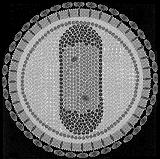Equine infectious anemia
| Equine infectious anemia virus | |
|---|---|

| |
| Virus classification | |
| Group: | Group VI (ssRNA-RT)
|
| Order: | Unassigned
|
| Family: | |
| Subfamily: | |
| Genus: | |
| Species: | Equine infectious anemia virus
|
Equine infectious anemia or equine infectious anaemia (EIA), also known by horsemen as swamp fever, is a horse disease caused by a retrovirus and transmitted by bloodsucking insects. The virus (EIAV) is endemic in the Americas, parts of Europe, the Middle and Far East, Russia, and South Africa. The virus is a lentivirus, like human immunodeficiency virus (HIV). Like HIV, EIA can be transmitted through blood, milk, and body secretions. Transmission is primarily through biting flies, such as the horse-fly and deer-fly.[1] The virus survives up to 4 hours in the carrier. Contaminated surgical equipment and recycled needles and syringes, and bits[2] can transmit the disease. Mares can transmit the disease to their foals via the placenta. The risk of transmitting the disease is greatest when an infected horse is ill, as the blood levels of the virus are then highest.
Stages
Acute: The acute form is a sudden onset of the disease at full-force. Symptoms include high fever, anemia (due to the breakdown of red blood cells), weakness, swelling of the lower abdomen and legs, weak pulse, and irregular heartbeat. The horse may die suddenly.
Subacute: A slower, less severe progression of the disease. Symptoms include recurrent fever, weight loss, an enlarged spleen (felt during a rectal examination), anemia, and swelling of the lower chest, abdominal wall, penile sheath, scrotum, and legs.
Chronic: Horse tires easily and is unsuitable for work. May have a recurrent fever and anemia, may relapse to the subacute or acute form even several years after the original attack.
A horse may also not appear to have any symptoms, yet still tests positive for EIA antibodies. This horse can still pass on the disease. According to most veterinarians, horses diagnosed EIA positive are usually not showing any sign of sickness or disease.
EIA may cause abortion in pregnant mares. This may occur at any time during the pregnancy if there is a relapse when the virus enters the blood. Most infected mares will abort, however some give birth to healthy foals. Foals are not necessarily infected.
Studies indicate that there are breeds with a tolerance to EIA.[3]
Recent studies in Brazil on living wild horses have shown that in the Pantanal, about 30% of domesticated and about 5.5% of the wild horses are chronically infected with EIA.[4]
Prevention and treatment
A vaccine is available, called "Chinese Live Attenuated EIA vaccine", developed in China and widely used there since 1983. Another attenuated live virus vaccine is in development in the United States.[5]
Reuse of syringes and needles is a risk factor for transfer of the disease. Currently in the United States, all horses that test positive must be reported to federal authorities by the testing laboratory. EIA-positive horses are infected for life. Options for the horse include sending the horse to a recognized research facility, branding the horse and quarantining it at least 200 yards from other horses for the rest of its life, and euthanizing the horse. Very few quarantine facilities exist which usually leads to the option of euthanizing the horse.The Florida Research Institute for Equine Nurturing, Development and Safety (a.k.a. F.R.I.E.N.D.S.) is one of the largest such quarantine facilities and is located in south Florida.[6] The horse industry and the veterinary industry strongly suggest that the risks posed by infected horses, even if they are not showing any clinical signs, are enough of a reason to impose such stringent rules. The precise impacts effect of the disease on the horse industry are unknown.
Diagnosis

The Coggins test (agar immunodiffusion) is a sensitive diagnostic test for equine infectious anemia developed by Dr. Leroy Coggins in the 1970s.
Currently, the USA does not have an eradication program due to the low rate of incidence, however many states require a negative Coggins test for interstate travel. In addition, most horse shows and events require a negative Coggins test. Most countries require a negative test result before allowing an imported horse into the country.
It is recommended to verify that all the horses at a breeding farm and or boarding facility have a negative Coggins test before using their services. A Coggins test should be done on an annual basis. Tests every 6 months are recommended if there is increased traveling.
References
- ^ "Equine Infectious Anemia: Introduction". The Merck Veterinary Manual. 2006. Retrieved 2007-06-23.
- ^ Equine Infectious Anemia (EIA), North Carolina Department of Agriculture and Consumer Services, retrieved December 19, 2008.
- ^ "Agricultural Biological Diversity", Convention on Biological Diversity, referenced August 12, 2008.
- ^ R.A.M.S. Silva (1999). "Swamp fever in wild horses from the Pantanal, Brazil" (PDF). Revue d'élevage et de médecine vétérinaire des pays tropicaux. 52 (2): 99–101. Retrieved 2010-10-17.
{{cite journal}}: Unknown parameter|coauthors=ignored (|author=suggested) (help) - ^ Craigo JK, Li F, Steckbeck JD, Durkin S, Howe L, Cook SJ, Issel C, Montelaro RC (2005). "Discerning an effective balance between equine infectious anemia virus attenuation and vaccine efficacy". J. Virol. 79 (5): 2666–77. doi:10.1128/JVI.79.5.2666-2677.2005. PMC 548432. PMID 15708986.
{{cite journal}}: CS1 maint: multiple names: authors list (link) - ^ http://www.eiahorses.org
External links
- The short film Equine Infectious Anemia: A Status Report (1996) is available for free viewing and download at the Internet Archive.
